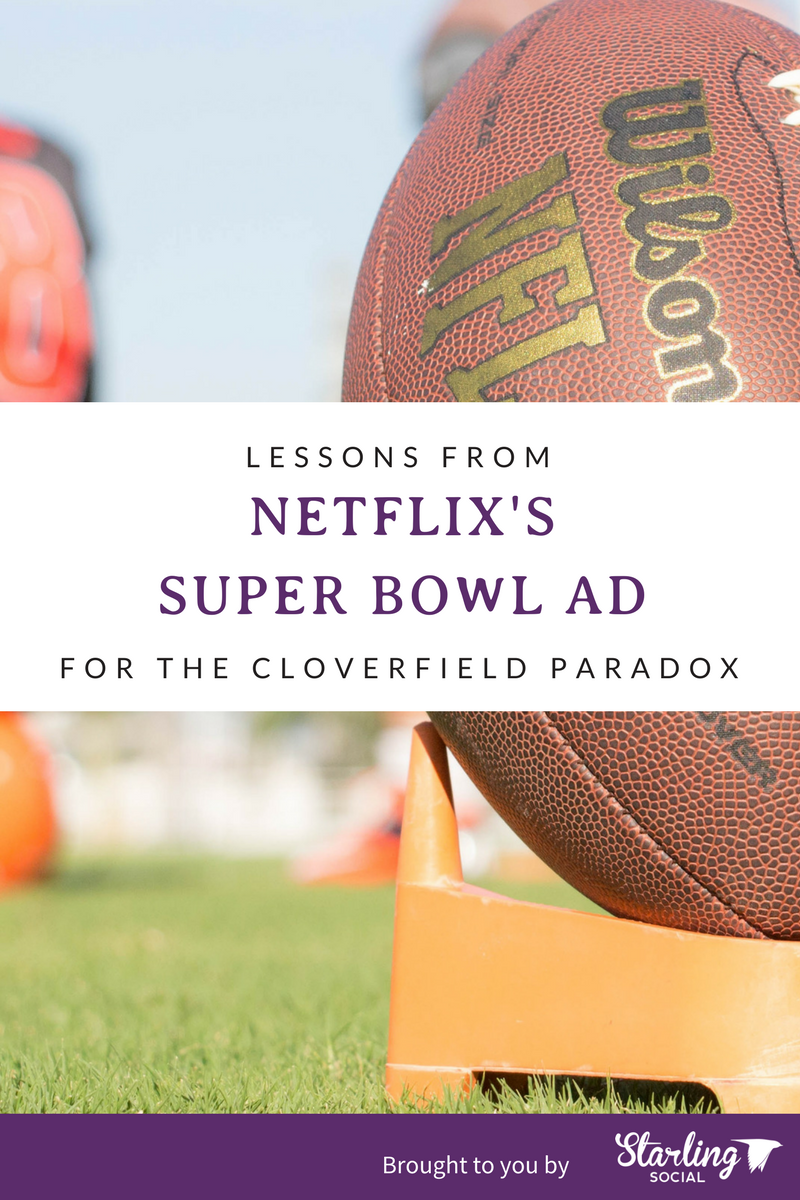Lessons From Netflix's Super Bowl Ad for The Cloverfield Paradox
- by Alyson Shane
Even if you don't watch football, the results of last night's Super Bowl LII should have left you with your jaw on the floor.
No - we're not talking about how the Eagles pulled ahead at the last minute thanks to the touchdown pass caught by QB Nick Foles; we're talking about Netflix's surprise ad and movie release for The Cloverfield Paradox.
For those of you who may have missed it, Netflix sprung a trick play on audiences by investing in a highly-coveted Super Bowl ad for the latest installment in J.J. Abrams' sci-fi franchise Cloverfield: The Cloverfield Paradox.
The ad, which aired during the second quarter, ends with text which reads: "coming very soon" which was followed by an announcement from Netflix stating that they would begin streaming the film online immediately after the game.
Naturally people began freaking out about it online, hailing it as one of the most innovative ways to market a box-office film ever. Netflix's edgy, innovative strategy upended traditional assumptions about how movie advertising is done, and it's likely that things will never be the same.
Even if you're not in the business of making movies (also called "show business") there's a lot brands from other industries can learn from Netflix's groundbreaking move.
Let's explore:

Experiment With Your Approach
We all know that buying a Super Bowl ad is one of the most effective (and expensive) ways to showcase your brand, product, or service to a captive audience of millions. In fact, it's not uncommon for movie studios to drop ads for upcoming theatrical releases during the Super Bowl.
What makes Netflix's approach different is that they barely gave their audience time to react to the ad before the movie started streaming. By breaking with the tradition of releasing teaser trailers, real-world ads, multiple full-length ads, and other traditional marketing tactics, Netflix broke the mold on traditional movie and TV advertising and gave audiences exactly what they wanted within hours of showing it to them.
Netflix took advantage of the energy, excitement, and captive audience generated by the Super Bowl and channeled as much of that engaged audience as possible into their digital streaming platform as soon as the game was over.
Your Takeaway
Don't be afraid to surprise your audience. We love the unexpected, especially when it comes to advertising, and breaking with tradition and experimenting on an ongoing basis will not only help you develop a better understanding of what your customers or clients behave, but you'll keep them on their toes which will keep them as engaged with your brand as possible.
Experiment With Audience Conversion Tactics
"You can't advertise during the Super Bowl and expect people to watch your movie right after!"
What do you think the odds are that someone, at some point throughout planning this campaign, said this? Pretty likely, and it's because what Netflix did flew in the face of traditional audience conversion tactics.
Think about it this way: Netflix managed to draw in an audience of viewers tuned into an unrelated live event and converted them to their digital streaming platform immediately after the event ended.
This is a huge risk for advertisers, as we know that it can be hard to replicate marketing ROI success across different audience types (Facebook audiences react to different content than LinkedIn audiences, for example) but Netflix wasn't afraid to experiment with a new approach which encouraged audiences to turn off one streaming service (their digital package or cable provider) and turn to another - their own.
Your Takeaway
If you know you have a captive audience on another platform or digital medium and you need to find ways of converting them, invest in ads specifically for the purpose of funneling them to your site or platform.
Don't be afraid to encourage cross-platform conversions! Pay attention to when audiences on other platforms are most engaged, or are likely to be online, and direct your advertising dollars into ads that run during those peak times in order to capitalize on the existing, engaged audience like Netflix did.
Don't be Afraid to Experiment. Period.
This isn't the first time that Netflix has shaken up traditional TV and movie advertising tactics.
Back in 2013, they shocked audiences by dropping all 13 episodes of House of Cards at once, effectively ushering in the age of binge-watching and changing how most people consume media.
At the time it was considered a groundbreaking move, but several years on the practice has become so commonplace that many of us allocate weekends to "binge" one season of a show or another. This shows us that taking risks and changing up traditional models can not only result in ongoing publicity and media - something every brand wants - but can fundamentally shape how your clients and customers interact with your products or services on an ongoing basis.
Your Takeaway
TRY NEW TACTICS.
If there's anything that this article and Netflix's strategies should tell you, it's that being bold and trying new methods of advertising, sharing information, and audience conversions is the way of the future.
Most brands are finding it harder and harder to stand out online, and the only way to create a viral hit à la Netflix is to step outside of your comfort zone and spend some time experimenting with new and innovative ways of reaching your audience.
With this new Super Bowl ad and immediate release Netflix has once again shown a determination to challenge the assumptions of traditional advertising, and we can't wait to see where they go next.
What's your reaction to Netflix's ad for The Cloverfield Paradox?
Let us know by dropping us a line on Facebook, Twitter, LinkedIn, or leave us a comment on Instagram!

